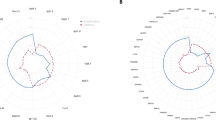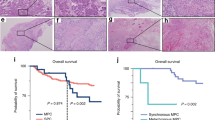Abstract
Oral tumors are a growing health problem worldwide; thus, it is mandatory to establish genetic markers in order to improve diagnosis and early detection of tumors, control relapses and, ultimately, delineate individualized therapies. This study was the first to evaluate and discuss the clinical applicability of a multiplex ligation-dependent probe amplification (MLPA) probe panel directed to head and neck cancer. Thirty primary oral squamous cell tumors were analyzed using the P428 MLPA probe panel. We detected genetic imbalances in 26 patients and observed a consistent pattern of distribution of genetic alterations in terms of losses and gains for some chromosomes, particularly for chromosomes 3, 8, and 11. Regarding the latter, some specific genes were highlighted due to frequent losses of genetic material—RARB, FHIT, CSMD1, GATA4, and MTUS1—and others due to gains—MCCC1, MYC, WISP1, PTK2, CCND1, FGF4, FADD, and CTTN. We also verified that the gains of MYC and WISP1 genes seem to suggest higher propensity of tumors localized in the floor of the mouth. This study proved the value of this MLPA probe panel for a first-tier analysis of oral tumors. The probemix was developed to include target regions that have been already shown to be of diagnostic/prognostic relevance for oral tumors. Furthermore, this study emphasized several of those specific genetic targets, suggesting its importance to oral tumor development, to predict patients’ outcomes, and also to guide the development of novel molecular therapies.



Similar content being viewed by others
References
Forastiere A, Koch W, Trotti A, Sidransky D. Head and neck cancer. N Engl J Med. 2001;345(26):1890–900.
Mitka M. Evidence lacking for benefit from oral cancer screening. JAMA. 2013;309(18):1884. doi:10.1001/jama.2013.4913.
Llewellyn CD, Johnson NW, Warnakulasuriya KA. Risk factors for squamous cell carcinoma of the oral cavity in young people—a comprehensive literature review. Oral Oncol. 2001;37(5):401–18.
Wittekindt C, Wagner S, Mayer CS, Klussmann JP. Basics of tumor development and importance of human papilloma virus (HPV) for head and neck cancer. GMS Curr Top Otorhinolaryngol Head Neck Surg. 2012;11:Doc09. doi:10.3205/cto000091.
Shah FD, Begum R, Vajaria BN, Patel KR, Patel JB, Shukla SN, et al. A review on salivary genomics and proteomics biomarkers in oral cancer. Indian J Clin Biochem. 2011;26(4):326–34. doi:10.1007/s12291-011-0149-8.
Schouten JP, McElgunn CJ, Waaijer R, Zwijnenburg D, Diepvens F, Pals G. Relative quantification of 40 nucleic acid sequences by multiplex ligation-dependent probe amplification. Nucleic Acids Res. 2002;30(12):e57.
Homig-Holzel C, Savola S. Multiplex ligation-dependent probe amplification (MLPA) in tumor diagnostics and prognostics. Diagn Mol Pathol. 2012;21(4):189–206. doi:10.1097/PDM.0b013e3182595516.
Wittekind C, Greene FL, Hutter RVP, Klimpfinger M. LH. S. TNM atlas. Illustrated guide to the TNM/pTNM classification of malignant tumours. 5th ed. Berlin: Springer; 2003.
Coffa J, Berg J. Analysis of MLPA data using novel software Coffalyser.NET by MRC-Holland. In: Eldin AB, editor. Modern approaches to quality control. Rijeka, Croatia: InTech; 2011. p. 125–50.
Nobre RJ, Cruz E, Real O, de Almeida LP, Martins TC. Characterization of common and rare human papillomaviruses in Portuguese women by the polymerase chain reaction, restriction fragment length polymorphism and sequencing. J Med Virol. 2010;82(6):1024–32. doi:10.1002/jmv.21756.
Bockmuhl U, Petersen S, Schmidt S, Wolf G, Jahnke V, Dietel M, et al. Patterns of chromosomal alterations in metastasizing and nonmetastasizing primary head and neck carcinomas. Cancer Res. 1997;57(23):5213–6.
Redon R, Muller D, Caulee K, Wanherdrick K, Abecassis J, du Manoir S. A simple specific pattern of chromosomal aberrations at early stages of head and neck squamous cell carcinomas: PIK3CA but not p63 gene as a likely target of 3q26-qter gains. Cancer Res. 2001;61(10):4122–9.
Ohta M, Inoue H, Cotticelli MG, Kastury K, Baffa R, Palazzo J, et al. The FHIT gene, spanning the chromosome 3p14.2 fragile site and renal carcinoma-associated t(3;8) breakpoint, is abnormal in digestive tract cancers. Cell. 1996;84(4):587–97.
Virgilio L, Shuster M, Gollin SM, Veronese ML, Ohta M, Huebner K, et al. FHIT gene alterations in head and neck squamous cell carcinomas. Proc Natl Acad Sci U S A. 1996;93(18):9770–5.
Saldivar JC, Bene J, Hosseini SA, Miuma S, Horton S, Heerema NA, et al. Characterization of the role of Fhit in suppression of DNA damage. Adv Biol Regul. 2013;53(1):77–85. doi:10.1016/j.jbior.2012.10.003.
Saldivar JC, Miuma S, Bene J, Hosseini SA, Shibata H, Sun J, et al. Initiation of genome instability and preneoplastic processes through loss of Fhit expression. PLoS Genet. 2012;8(11):e1003077. doi:10.1371/journal.pgen.1003077.
Lotan R, Xu XC, Lippman SM, Ro JY, Lee JS, Lee JJ, et al. Suppression of retinoic acid receptor-beta in premalignant oral lesions and its up-regulation by isotretinoin. N Engl J Med. 1995;332(21):1405–10. doi:10.1056/NEJM199505253322103.
Zou CP, Youssef EM, Zou CC, Carey TE, Lotan R. Differential effects of chromosome 3p deletion on the expression of the putative tumor suppressor RAR beta and on retinoid resistance in human squamous carcinoma cells. Oncogene. 2001;20(47):6820–7. doi:10.1038/sj.onc.1204846.
O’Shaughnessy JA, Kelloff GJ, Gordon GB, Dannenberg AJ, Hong WK, Fabian CJ, et al. Treatment and prevention of intraepithelial neoplasia: an important target for accelerated new agent development. Clin Cancer Res. 2002;8(2):314–46.
Murugan AK, Hong NT, Fukui Y, Munirajan AK, Tsuchida N. Oncogenic mutations of the PIK3CA gene in head and neck squamous cell carcinomas. Int J Oncol. 2008;32(1):101–11.
Hermsen M, Guervos MA, Meijer G, Baak J, van Diest P, Marcos CA, et al. New chromosomal regions with high-level amplifications in squamous cell carcinomas of the larynx and pharynx, identified by comparative genomic hybridization. J Pathol. 2001;194(2):177–82.
Sun PC, Uppaluri R, Schmidt AP, Pashia ME, Quant EC, Sunwoo JB, et al. Transcript map of the 8p23 putative tumor suppressor region. Genomics. 2001;75(1–3):17–25. doi:10.1006/geno.2001.6587.
Ma C, Quesnelle KM, Sparano A, Rao S, Park MS, Cohen MA, et al. Characterization CSMD1 in a large set of primary lung, head and neck, breast and skin cancer tissues. Cancer Biol Ther. 2009;8(10):907–16.
\Akiyama Y, Watkins N, Suzuki H, Jair KW, van Engeland M, Esteller M, et al. GATA-4 and GATA-5 transcription factor genes and potential downstream antitumor target genes are epigenetically silenced in colorectal and gastric cancer. Mol Cell Biol. 2003;23(23):8429–39.
Hellebrekers DM, Lentjes MH, van den Bosch SM, Melotte V, Wouters KA, Daenen KL, et al. GATA4 and GATA5 are potential tumor suppressors and biomarkers in colorectal cancer. Clin Cancer Res. 2009;15(12):3990–7. doi:10.1158/1078-0432.CCR-09-0055.
Zheng R, Blobel GA. GATA Transcription factors and cancer. Genes & Cancer. 2010;1(12):1178–88. doi:10.1177/1947601911404223.
Seibold S, Rudroff C, Weber M, Galle J, Wanner C, Marx M. Identification of a new tumor suppressor gene located at chromosome 8p21.3–22. FASEB J. 2003;17(9):1180–2. doi:10.1096/fj.02-0934fje.
Zhou X, Temam S, Oh M, Pungpravat N, Huang BL, Mao L, et al. Global expression-based classification of lymph node metastasis and extracapsular spread of oral tongue squamous cell carcinoma. Neoplasia. 2006;8(11):925–32. doi:10.1593/neo.06430.
Ye H, Pungpravat N, Huang BL, Muzio LL, Mariggio MA, Chen Z, et al. Genomic assessments of the frequent loss of heterozygosity region on 8p21.3–p22 in head and neck squamous cell carcinoma. Cancer Genet Cytogenet. 2007;176(2):100–6. doi:10.1016/j.cancergencyto.2007.04.003.
Squire JA, Bayani J, Luk C, Unwin L, Tokunaga J, MacMillan C, et al. Molecular cytogenetic analysis of head and neck squamous cell carcinoma: by comparative genomic hybridization, spectral karyotyping, and expression array analysis. Head Neck. 2002;24(9):874–87. doi:10.1002/hed.10122.
da Silva Veiga LC, Bergamo NA, dos Reis PP, Kowalski LP, Rogatto SR. DNA gains at 8q23.2: a potential early marker in head and neck carcinomas. Cancer Genet Cytogenet. 2003;146(2):110–5.
Saranath D, Panchal RG, Nair R, Mehta AR, Sanghavi V, Sumegi J, et al. Oncogene amplification in squamous cell carcinoma of the oral cavity. Jpn J Cancer Res. 1989;80(5):430–7.
Vora HH, Shah NG, Patel DD, Trivedi TI, Chikhlikar PR. Prognostic significance of biomarkers in squamous cell carcinoma of the tongue: multivariate analysis. J Surg Oncol. 2003;82(1):34–50. doi:10.1002/jso.10183.
Babic AM, Kireeva ML, Kolesnikova TV, Lau LF. CYR61, a product of a growth factor-inducible immediate early gene, promotes angiogenesis and tumor growth. Proc Natl Acad Sci U S A. 1998;95(11):6355–60.
Hashimoto Y, Shindo-Okada N, Tani M, Takeuchi K, Toma H, Yokota J. Identification of genes differentially expressed in association with metastatic potential of K-1735 murine melanoma by messenger RNA differential display. Cancer Res. 1996;56(22):5266–71.
Soon LL, Yie TA, Shvarts A, Levine AJ, Su F, Tchou-Wong KM. Overexpression of WISP-1 down-regulated motility and invasion of lung cancer cells through inhibition of Rac activation. J Biol Chem. 2003;278(13):11465–70. doi:10.1074/jbc.M210945200.
Canel M, Secades P, Rodrigo JP, Cabanillas R, Herrero A, Suarez C, et al. Overexpression of focal adhesion kinase in head and neck squamous cell carcinoma is independent of fak gene copy number. Clin Cancer Res. 2006;12(11 Pt 1):3272–9. doi:10.1158/1078-0432.CCR-05-1583.
Owens LV, Xu L, Craven RJ, Dent GA, Weiner TM, Kornberg L, et al. Overexpression of the focal adhesion kinase (p125FAK) in invasive human tumors. Cancer Research. 1995;55(13):2752–5.
Schuuring E. The involvement of the chromosome 11q13 region in human malignancies: cyclin D1 and EMS1 are two new candidate oncogenes—a review. Gene. 1995;159(1):83–96.
Gibcus JH, Menkema L, Mastik MF, Hermsen MA, de Bock GH, van Velthuysen ML, et al. Amplicon mapping and expression profiling identify the Fas-associated death domain gene as a new driver in the 11q13.3 amplicon in laryngeal/pharyngeal cancer. Clin Cancer Res. 2007;13(21):6257–66.
Lese CM, Rossie KM, Appel BN, Reddy JK, Johnson JT, Myers EN, et al. Visualization of INT2 and HST1 amplification in oral squamous cell carcinomas. Genes Chromosomes Cancer. 1995;12(4):288–95.
Parikh RA, White JS, Huang X, Schoppy DW, Baysal BE, Baskaran R, et al. Loss of distal 11q is associated with DNA repair deficiency and reduced sensitivity to ionizing radiation in head and neck squamous cell carcinoma. Genes Chromosomes Cancer. 2007;46(8):761–75. doi:10.1002/gcc.20462.
Huang Q, Yu GP, McCormick SA, Mo J, Datta B, Mahimkar M, et al. Genetic differences detected by comparative genomic hybridization in head and neck squamous cell carcinomas from different tumor sites: construction of oncogenetic trees for tumor progression. Genes, Chromosomes and Cancer. 2002;34(2):224–33. doi:10.1002/gcc.10062.
Leemans CR, Braakhuis BJ, Brakenhoff RH. The molecular biology of head and neck cancer. Nat Rev Cancer. 2011;11(1):9–22.
Nix PA, Greenman J, Cawkwell L, Stafford ND. Defining the criteria for radioresistant laryngeal cancer. Clin Otolaryngol Allied Sci. 2004;29(6):705–8. doi:10.1111/j.1365-2273.2004.00861.x.
Jeuken J, Cornelissen S, Boots-Sprenger S, Gijsen S, Wesseling P. Multiplex ligation-dependent probe amplification: a diagnostic tool for simultaneous identification of different genetic markers in glial tumors. J Mol Diagn. 2006;8(4):433–43. doi:10.2353/jmoldx.2006.060012.
Acknowledgments
The authors are grateful to Dr. Artur Ferreira, Director of Maxillofacial Surgery Unit from Coimbra Hospital and University Centre, for the contribution in the collection of the samples. This work was supported in part by CIMAGO (Center of Investigation on Environment Genetics and Oncobiology, Faculty of Medicine, University of Coimbra).
Conflicts of interest
W. Rifi and S. Savola are employed by MRC-Holland, manufacturer of commercially available MLPA probemixes. All other authors declare no competing financial interests.
Author information
Authors and Affiliations
Corresponding author
Rights and permissions
About this article
Cite this article
Ribeiro, I.P., Marques, F., Caramelo, F. et al. Genetic imbalances detected by multiplex ligation-dependent probe amplification in a cohort of patients with oral squamous cell carcinoma—the first step towards clinical personalized medicine. Tumor Biol. 35, 4687–4695 (2014). https://doi.org/10.1007/s13277-014-1614-9
Received:
Accepted:
Published:
Issue Date:
DOI: https://doi.org/10.1007/s13277-014-1614-9




